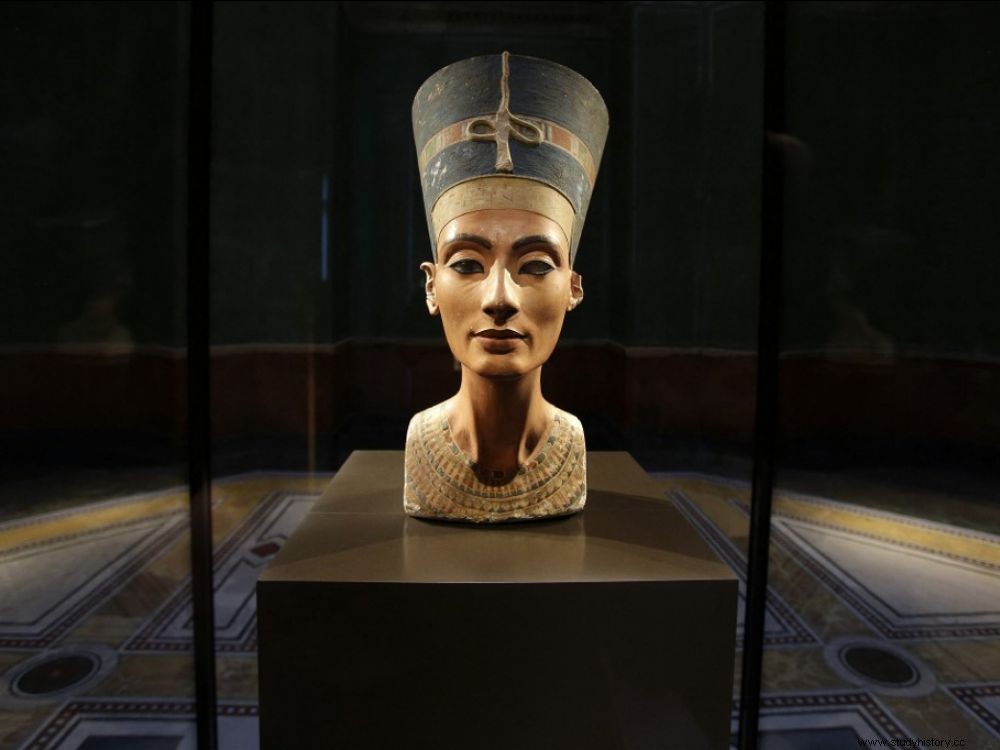This period of stability and economic success, also marked by the religious revolution of Akhenaten, gave Egypt, at its height, its most famous sovereigns. Hatshepsout, Tutankhamun, Ramses II… are buried in sumptuous underground tombs.

Bust of Nefertiti, wife of the "heretic" Pharaoh Akhenaten.
This article is from the Special Issue of Sciences et Avenir n°197 dated April-May 2019.
History
XVIII DYNASTY – XX DYNASTY
During this period during which the Thutmosids reign (XVIII th dynasty) then the Ramessides (XIX th -XX e dynasties), the capitals are in turn the cities of Thebes, Memphis and Per-Ramses. Political power shifts from Upper Egypt to the eastern Delta in order to protect Egyptian commercial interests in Syria-Palestine. But the economic crisis caused by the loss of the rich territories of this region carries the New Empire.
Politics and religion
The royal tombs of Thebes in the Valley of the Kings were vandalized from the reign of Ramses IX and their treasures looted, against a backdrop of economic crisis. Investigations are carried out to assess the plunders, but the latter continue until the reign of Ramses XI, in a context of civil war. Influential in Thebes, the priests of Amun participate in thefts to finance the defense of their city and its region.
Under Amenhotep IV, religion is shaken. The sovereign, who exchanged his name for that of Akhenaton, chose a new capital, Akhétaton ("the horizon of the disc "), the current Amarna, where a new deity, the sun god Aten, is venerated and soon raised to the rank of unique god. But the city is abandoned under his successor Tutankhamun. Remains of this ephemeral episode of Egyptian history a particular figurative art prescribed by the sovereign (elongated facial features, flourishing body shapes) to distinguish the royal family from ordinary mortals.
Sites and monuments
While since the time of the pyramids, the funerary temples were erected near the royal tombs, in the New Kingdom, the tombs were built in the mountains (Valley of the Kings) and the funerary temples in the desert:"castles of millions of years" where the royal cult is associated with that of the god Amon.
The Valley of the Kings, on the left bank of the Nile, facing Thebes, became the necropolis of the pharaohs. From Thutmose I st , the sovereigns are buried in hypogea, tombs with an underground vault dug into the mountain.
Tutankhamun's tomb is the first (and only) royal tomb found almost intact. Around four thousand precious objects have been unearthed there, including the king's famous death mask.
The necropolis of the Valley of the Queens, to the south-west of the Valley of the Kings, houses the hypogea of the wives and daughters of the Ramesside kings - that is to say descended from Ramesses I st (XIX e and XX th dynasties) -, but also the tombs of the sons of the great Pharaoh Ramses III.
The arts and palaces
Among the temples - accessible only to the king and the priests who worship the gods there - and the colossal funerary complexes:Karnak, the largest temple in Egypt, built between the Middle Kingdom and Roman times. Amon is venerated there, in an official cult far removed from personal piety.
Luxor Temple, built south of Karnak by Amenhotep III then Ramses II.
The Colossi of Memnon:These two statues on the western bank of Thebes stood in the forecourt of a temple belonging to the funerary complex of Amenhotep III, now extinct.
The temples of Abydos and the palace of Perramses with blue faience, near ancient Avaris, two achievements of Seti I st .
Among the many constructions of Ramses II, the Great Temple and the Small Temple of Abu Simbel, south of Aswan, in Lower Nubia, saved by Unesco between 1963 and 1968.
Iconic figures
The noble Theban Thutmose begets a famous royal line:that of Hatshepsut the queen-pharaoh, Thutmose III, Amenhotep IV-Akhenaton and Tutankhamun. It's the 18 th dynasty, the best known in pharaonic history. Among these rulers, the great conqueror Thutmose III submits a large part of Syria-Palestine.
Ramses II, pharaoh builder in the image of his father Seti I st , reigned 66 years over a prosperous country, erecting numerous sanctuaries - including his own funerary temple, the Ramesseum, on the left bank of Thebes -, colossi and obelisks. Monuments whose splendor will no longer be equaled in later periods.
Funeral literature
The Book of the Dead (Formulas to get out at day or Soul out into the light of day , in Egyptian) is a guide to the afterlife intended to help the deceased face the ordeal of soul judgment. Extracts intended for dignitaries but also for the middle class were copied from it on rolls of papyrus placed next to the mummy, or even, in the Late Period, on its strips.
Egypt and its neighbors
The period is stable and the economy of ebony, gold, or hides; Egypt, a great commercial and cultural power, flourishing. The Thutmosides extend their power over the whole of Nubia and conquer the Levant (present-day Palestine). They lead great maritime expeditions, like the one sent to the land of Punt by Queen Hatshepsut to obtain incense, ivory, these riches also reach Egypt via the caravans of merchants. After the battle of Qadesh (circa 1286) led by Ramses II against the Hittites to wrest Syria from them, the signing of a peace treaty and the accumulated wealth from the Near East and Nubia enabled the pharaoh to cover the country of superb monuments, notably at Abu Simbel. More than thirty years later, Ramses III drove back the enemies of Egypt, including the fearsome Sea Peoples who ravaged the coasts of Syria-Palestine.
By Laureen Bouyssou
